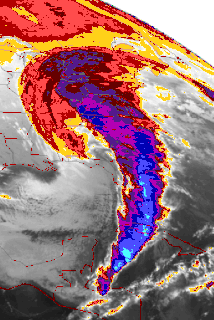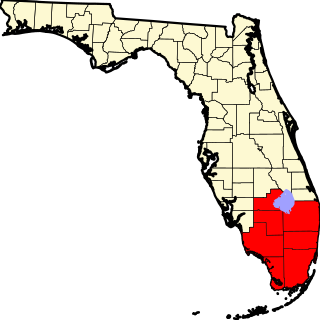
Tampa is a major city in and the county seat of, Hillsborough County, Florida, United States. It is on the west coast of Florida on Tampa Bay, near the Gulf of Mexico. Tampa is the largest city in the Tampa Bay area. With an estimated population of 399,700 in 2019, Tampa is the 48th most-populous city in the U.S. and the third-largest city in Florida after Miami and Jacksonville. The bay's port is the largest in the state, near downtown's Channel District. Bayshore Boulevard runs along the bay and is east of the historic Hyde Park neighborhood.

The Tampa Bay area is a major populated area surrounding Tampa Bay on the west coast of Florida in the United States. It includes the main cities of Tampa, St. Petersburg, and Clearwater. It is the eighteenth largest metropolitan area in the United States, with an estimated population of over three million.

The 1993 Storm of the Century was a large cyclonic storm that formed over the Gulf of Mexico on March 12, 1993. The storm was unique and notable for its intensity, massive size, and wide-reaching effects; at its height, the storm stretched from Canada to Honduras. The cyclone moved through the Gulf of Mexico and then through the eastern United States before moving on to eastern Canada. The storm eventually dissipated in the North Atlantic Ocean on March 15.

Bay News 9 is a cable news television network located in St. Petersburg, Florida. Owned by Charter Communications, it currently serves the Tampa Bay area including Hillsborough, Pinellas, Manatee, Polk, Pasco, Hernando, and Citrus counties. The station, which is exclusive to Spectrum customers, provides rolling news programming 24 hours a day, with the exception of some special programming, including a weekly political program, Political Connections.
The 1998 Kissimmee tornado outbreak of February 22–23, 1998, was a devastating tornado outbreak, the deadliest tornado event in Florida history, that is sometimes known as The Night of the Tornadoes. Affecting the I-4 corridor of Central Florida, including the Greater Orlando area, the tornadoes—among the strongest ever recorded in Florida—produced F3 damage, killed 42 people, and caused 260 injuries. The previous record for the highest tornado death toll in Florida history was 17 on March 31, 1962. In all, 12 tornadoes touched down, one of which was long lived and tracked for nearly 30 miles (48 km). The first major, F3 tornado of the outbreak came at around 11:40 pm in Winter Garden, near Windermere in Orange County, killing three people. The deadliest and most destructive tornado of the night struck Kissimmee and St. Cloud, where 25 people were killed, and produced near-F4 damage. Only two other tornadoes, both rated F4, in 1958 and 1966 produced more intense damage in Florida. Another F3 hit in Seminole County, near Sanford, and in Volusia County, killing 13. The last tornado of the night was a weak F1 that hit the town of Cape Canaveral in Brevard County.

The 1944 Cuba–Florida hurricane was a large Category 4 tropical cyclone on the Saffir–Simpson hurricane wind scale that caused widespread damage across the western Caribbean Sea and Southeastern United States in October 1944. It inflicted over US$100 million in damage and caused at least 318 deaths, the majority of fatalities occurring in Cuba. One study suggested that an equivalent storm in 2018 would rank among the costliest U.S. hurricanes. The full extent of the storm's effects remains unclear due to a dearth of conclusive reports from rural areas of Cuba. The unprecedented availability of meteorological data during the hurricane marked a turning point in the United States Weather Bureau's ability to forecast tropical cyclones.

News 13 is an American cable news television channel that is owned by Charter Communications. The channel provides 24-hour rolling news coverage focused primarily on Central Florida, specifically Brevard, Flagler, Lake, Marion, Orange, Osceola, Seminole, Sumter, and Volusia counties.

It is very rare for snow to fall in the U.S. state of Florida, especially in the central and southern portions of the state. With the exception of the far northern areas of the state, most of the major cities in Florida have never recorded measurable snowfall, though trace (T) amounts have been recorded, or flurries in the air observed few times each century. According to the National Weather Service, in the Florida Keys and Key West there is no known occurrence of snow flurries since the European colonization of the region. In Miami, Ft. Lauderdale, and Palm Beach there is only one known report in more than 200 years of snow flurries observed in the air; this occurred in January 1977. In any event, Miami, Ft. Lauderdale, and Palm Beach have not seen snow flurries before or since this 1977 event.

The 2007 Groundhog Day tornado outbreak was a localized but devastating tornado event that took place in central Florida early on February 2, 2007. Early morning temperatures had risen well above average for the season; combined with increased moisture and a powerful jet stream, this created enough instability and wind shear for thunderstorms to rotate and spawn tornadoes. Due to the conditions, a long-tracked supercell formed and produced three tornadoes over one hour and seventeen minutes. The supercell resulted in a 70-mile (110-kilometer) trail of damage.

The climate of the north and central parts of the US state of Florida is humid subtropical. Most of South Florida has a tropical climate. There is a defined rainy season from May through October, when air mass thundershowers that build in the heat of the day drop heavy but brief summer rainfall.

An extreme wind warning is an alert issued by the National Weather Service for areas that will experience sustained surface winds 100 knots or greater within one hour, due to a landfalling hurricane. The winds may also be associated with non-convective, downslope, or derecho winds.

A deadly tornado family the I-4 corridor in Central Florida from the Tampa Bay area to Brevard County on Monday, April 4, 1966. Two tornadoes affected the region, each of which featured a path length in excess of 100 miles (160 km). One of the tornadoes produced estimated F4 damage on the Fujita scale; it remains one of only two F4 tornadoes to strike the U.S. state of Florida, the other of which occurred in 1958. Both F4 tornadoes occurred during El Niño years. A total of 11 people were killed across the state, including three in the city of Tampa and seven in Polk County. The F4 tornado remains the fourth-deadliest tornado event recorded in Florida; only tornadoes on March 1962, February 2007, and February 1998 caused more deaths in the state. All of the events were induced by non-tropical cyclones. The two tornadoes are officially listed as continuous events, but the tornadoes' damage paths did not cross the entire state, and downbursts may have been responsible for destruction near Lake Juliana and the Kissimmee–Saint Cloud area. However, the combination of tornado and downburst destruction was continuous in Central Florida.

The Tampa Bay area has a humid subtropical climate closely bordering a tropical monsoon climate near the waterfront areas. There are two basic seasons in the Tampa Bay area, a hot and wet season from May through October, and a mild and dry season from November through April.

The National Weather Service Miami, Florida is a local weather forecast office of the National Weather Service (NWS) that serves six counties in South Florida – Broward, Collier, Glades, Hendry, Miami-Dade, and Palm Beach – as well as the mainland portion of Monroe County. This office was originally established in 1879 as a Signal Corps station near the Jupiter Inlet Light, before becoming a Weather Bureau Office (WBO) in 1891. The WBO at Jupiter was moved southward to Miami, due to the city's rapidly growing population. In 1930, a separate Weather Bureau Airport Station (WBAS) was established at the Miami Municipal Airport. The WBAS was later moved to the Miami International Airport in 1942 and remained there until ceasing operations in 1975.

The passage of Hurricane Isaac generated a long-lived, nine-day tornado outbreak that affected the Central and Eastern United States from August 27 to September 4, 2012. The hurricane produced a total of 34 tornadoes, with the strongest being two EF2 tornadoes in Mississippi and Arkansas. There were 19 tornado watches were issued for Isaac over eight days and 171 tornado warnings were issued across 12 states, with 77 of them in Mississippi.

An unusually prolific and very destructive late-winter tornado outbreak resulted in significant damage and numerous casualties across the southern and eastern half of the United States between February 23–24, 2016. Lasting nearly a day and a half, the outbreak produced a total of 61 tornadoes across eleven states, which ranked it as one of the largest February tornado outbreaks in the United States on record, with only the 2008 Super Tuesday tornado outbreak having recorded more. In addition, it was also one of the largest winter tornado outbreaks overall as well. The most significant and intense tornadoes of the event were four EF3s that struck southeastern Louisiana, Pensacola, Florida, Evergreen, Virginia, and Tappahannock, Virginia. Tornadoes were also reported in other places like Texas, Florida, and Pennsylvania. Severe thunderstorms, hail and gusty winds were also felt in the Northeastern United States and Mid-Atlantic states on February 24 as well.

The tornado outbreak of January 21–23, 2017 was a prolific and deadly winter tornado outbreak that occurred across the Southeast United States. Lasting just under two days, the outbreak produced a total of 81 tornadoes, cementing its status as the second-largest January tornado outbreak and the third-largest winter tornado outbreak since 1950. Furthermore, it was the largest outbreak on record in Georgia with 42 tornadoes confirmed in the state. The most significant tornadoes were three EF3s that heavily damaged or destroyed portions of Hattiesburg, Mississippi, and Albany and Adel, Georgia. A total of 20 people were killed by tornadoes—mainly during the pre-dawn hours of the outbreak—making it the second-deadliest outbreak in January since 1950, behind the 1969 Hazlehurst, Mississippi tornado outbreak that killed 32 people. In the aftermath of the outbreak, relief organizations assisted in clean-up and aid distribution. Total economic losses from the event reached at least $1.3 billion.
















